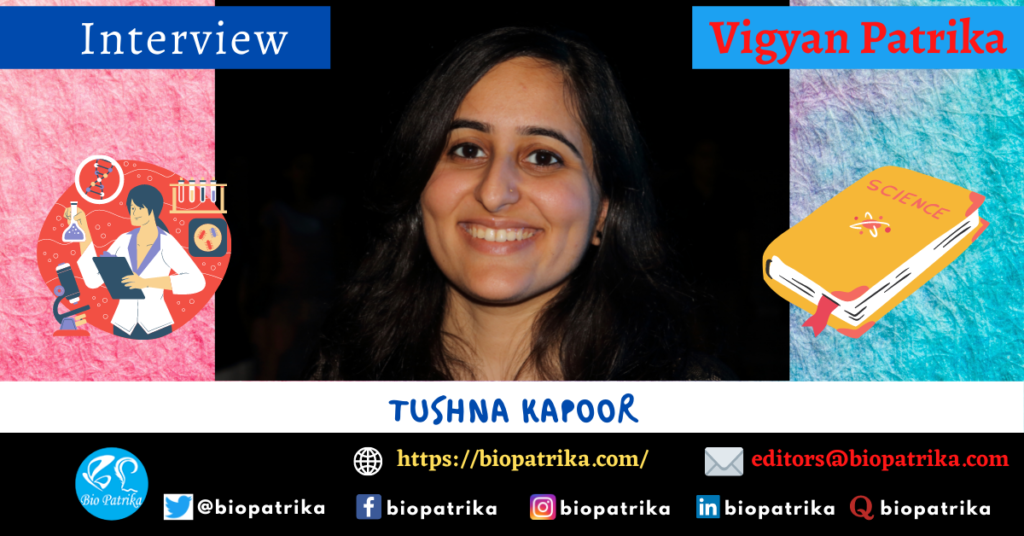Dr. Tushna Kapoor’s interview with Bio Patrika hosting “Vigyaan Patrika,” a series of author interviews. Tushna did her bachelor’s in Biochemistry, from Sri Venkateswara College, University of Delhi. Subsequently, she joined the Tata Institute of Fundamental Research (TIFR), in Mumbai, where she worked in the laboratory of Prof. Krishanu Ray, as an integrated Ph.D. student. Tushna’s doctoral work involves deciphering the role of the cell membrane, cytoskeleton, and cell adhesion remodeling during spermatid maturation in Drosophila. Her recent paper shows that the somatic cell plasma membrane folded around maturing spermatid heads can recruit a repertoire of proteins that assemble a membrane-cytoskeleton substructure, which clamps together the spermatid heads, and also prevents them from piercing through the somatic cell membrane. This work highlights novel roles of membrane-actin interactions, in an in vivo tissue system. Tushna is currently working at the Institute of Science and Technology (IST), Austria.
How would you explain your paper’s key results to the non-scientific community?
Cells are covered by a plasma membrane, which is composed of lipids and proteins. The plasma membrane can undergo deformations to form inward and outward bends, to perform various functions such as- cell migration, tissue shape changes during development, or to internalize or excrete various substances. The plasma membrane can also ‘feel’ the shape, stiffness and micropatterns of their surrounding substrate, and accordingly modulate the cellular properties, such as- its potential to migrate, divide, or differentiate into a particular cell type. However, the underlying mechanisms of ‘sensing’ and the molecular players involved in bringing about these changes remained unclear in an in vivo tissue context.
Interestingly, with our work in Drosophila, we found that the somatic cell plasma membrane which is folded around nano-rod-like spermatid heads (approximately 200nm in diameter), recruits a cascade of proteins, via a specialised membrane-associated protein known as Amphiphysin. These proteins form a subcellular clamp-like structure, called ‘basket.’ The basket tethers the maturing spermatid heads together, and thus prevents them from piercing through the somatic cell membrane, thereby preventing the improper sperm release.

What are the possible consequences of these findings for your research area?
Membrane-cytoskeletal remodeling at the cellular and tissue-scale is fundamental to development and homeostasis. Our study, together with the previous work from our lab, shows that the time-scale and local bending of the plasma membrane can lead to the formation of specialised membrane-cytoskeletal substructures, with differing properties and dynamics.
The ability to monitor these changes in the in vivo tissue context opens the opportunity to explore several exciting questions. For instance, the mechanical cues involved in the formation of these different structures, exploring the cross-talk of these structures and identifying the feedback loop between membrane-actin networks, among several others.
If you want new ideas, read old books
What was the exciting moment (eureka moment) during your research?
Visualizing the actin dynamics by live imaging and watching the time-lapse movies over and over again always revealed new and interesting observations. There are a lot of dynamic changes in the membrane and actin cytoskeleton happening during the terminal stages of spermatid maturation. Being a rather under-studied model, we discovered many unusual and fascinating processes.
A particularly eye-catching piece of data is the live imaging following drug treatment, wherein we pharmacologically inhibited the activity of the kinase ROCK. This led to shearing of the basket and loss of bundling of spermatid heads. While we saw similar observations many times in the fixed tissue data, capturing the real-time disruption of these structures sealed the deal about the role of the basket and the proteins involved in its functioning.
What do you hope to do next?
I am currently working in the lab of Prof. Carl-Philipp Heisenberg, at the Institute of Science and Technology (IST) Austria, where I am working on the mechanisms involved in tissue spreading during epiboly in zebrafish embryos.
Where do you seek scientific inspiration?
‘If you want new ideas, read old books’- I find this quote immensely true in the scientific context as well. Seminal papers can often provide key observations, which can help connect the dots and allow us to see beyond the obvious.
Reference
Tushna Kapoor, Pankaj Dubey, Seema Shirolikar and Krishanu Ray. An actomyosin clamp assembled by the Amphiphysin-Rho1-Dia/DAAM-Rok pathway reinforces somatic cell membrane folded around spermatid heads. Cell Reports, Volume 34, Issue 13, 108918.
Edited by: Sukanya Madhwal
